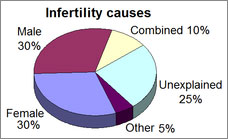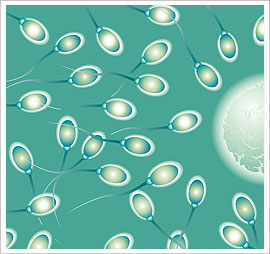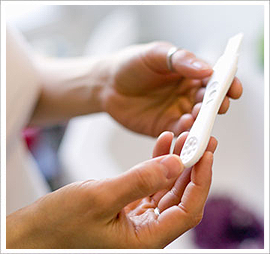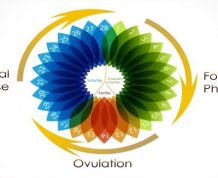 Approximately six million people are currently battling infertility. Now couples aren’t typically given the diagnosis of infertility until they have tried to conceive for at least a year with no success. While you may feel everyone is getting pregnant around you at the drop of a hat, the numbers do speak of it taking longer than always anticipated. On average, only 25% of couples will conceive within their first month of trying. Just over 50% of couples will get pregnant within six months, 75% within nine months and 90% within a year-and-a-half. If you have been actively trying and timing intercourse exactly during ovulation for an entire year, then it’s time to seek out your healthcare professional to see what the problem may be and to find out all the possible solutions. Claim Your 20 Free Pregnancy Tests – Click Here
Approximately six million people are currently battling infertility. Now couples aren’t typically given the diagnosis of infertility until they have tried to conceive for at least a year with no success. While you may feel everyone is getting pregnant around you at the drop of a hat, the numbers do speak of it taking longer than always anticipated. On average, only 25% of couples will conceive within their first month of trying. Just over 50% of couples will get pregnant within six months, 75% within nine months and 90% within a year-and-a-half. If you have been actively trying and timing intercourse exactly during ovulation for an entire year, then it’s time to seek out your healthcare professional to see what the problem may be and to find out all the possible solutions. Claim Your 20 Free Pregnancy Tests – Click Here

 One-third of the cases of infertility are due to men. The main causes of infertility in men are due to low sperm count or poor sperm mobility. Any of the following can cause low sperm count in men:
One-third of the cases of infertility are due to men. The main causes of infertility in men are due to low sperm count or poor sperm mobility. Any of the following can cause low sperm count in men:
Varicocele — an abnormal collection of bulging veins above the testicle
Undescended testicle
Infections in the testicle or the prostate
Chemotherapy for cancer treatment
Use of anabolic steroids or anti-seizure medicines
Genetic problems
Hormonal issues
Some men have an adequate sperm count in the testicles, but their problem may be in getting the sperm where it needs to go. There are any number of causes for this. To diagnosis male factor infertility, your partner will need to go to a doctor specializing in male infertility where he will first perform a sperm & semen analysis. His healthcare provider will then be able to make the correct diagnosis, to find the treatment that will suit him best. Various conditions cited above can be corrected with surgical procedures or medicines, while there is always the possibility of intra-uterine insemination (IUI) where the sperm is inserted directly into the woman’s uterus.
Whatever the case may be, if you have been experiencing infertility for over a year, then it is important to encourage your partner to get checked out, however hard it may be. There are so many treatments out there, it’s good to find the diagnosis and get moving toward the baby of your dreams.

 While men account for 1/3 of all cases of infertility, women account for another third themselves. For women, the main problem tends to be ovulation issues. Women are born with only a finite number of eggs at birth, and from age 30 on, that number depletes by 3-5% per year, exponentially so past age 40. There are numerous causes of infertility in women, like endometriosis, uterine fibroids, or a hormonal imbalance causing ovulation difficulties. If female infertility is suspected, your healthcare provider will order several tests including a blood test to check hormone levels as well as an endometrial biopsy to check the lining of the uterus.
While men account for 1/3 of all cases of infertility, women account for another third themselves. For women, the main problem tends to be ovulation issues. Women are born with only a finite number of eggs at birth, and from age 30 on, that number depletes by 3-5% per year, exponentially so past age 40. There are numerous causes of infertility in women, like endometriosis, uterine fibroids, or a hormonal imbalance causing ovulation difficulties. If female infertility is suspected, your healthcare provider will order several tests including a blood test to check hormone levels as well as an endometrial biopsy to check the lining of the uterus.
Now once the diagnosis of infertility has been given, the majority of doctors will prescribe fertility drugs to aide in getting pregnant. Another option which is a bit more expensive is IVF, and IVF stands for in vitro fertilization. And by expensive, it’s somewhere in the ballpark of ten to fifteen thousand dollars. Typically, your doctor will begin with fertility drugs to help stimulate ovulation, the most commonly prescribed drug being Clomid. Only after this treatment method is tried & if it fails does your doctor move on to other measures.

 If you think you’re battling infertility, don’t go running to a specialist just yet. A general rule of thumb is that if you’re under the age of 35, you want to wait a bare minimum of twelve months of trying to conceive without any success. Whereas, if you’re over 35, this changes to only six months. By age 38, don’t delay. Seek out assistance quicker, as between the ages of 38 & 40, a woman’s natural fertility sharply declines. After the age of 40, a woman’s fertility rate is 5% per month, this being due to the vastly reduced number of eggs a woman has. So after the age of 40, you should consult your healthcare provider for assistance after only 3 months of actively trying to conceive.
If you think you’re battling infertility, don’t go running to a specialist just yet. A general rule of thumb is that if you’re under the age of 35, you want to wait a bare minimum of twelve months of trying to conceive without any success. Whereas, if you’re over 35, this changes to only six months. By age 38, don’t delay. Seek out assistance quicker, as between the ages of 38 & 40, a woman’s natural fertility sharply declines. After the age of 40, a woman’s fertility rate is 5% per month, this being due to the vastly reduced number of eggs a woman has. So after the age of 40, you should consult your healthcare provider for assistance after only 3 months of actively trying to conceive.
So again, the general rule of thumb is to wait 12 months if under the age of 35, 6 months between 35-40 and 3 months after the age of 40. Be sure to be charting your BBT temps during this waiting period, to arm yourself with as much data that an infertility specialist can use to best assist you.









Comments